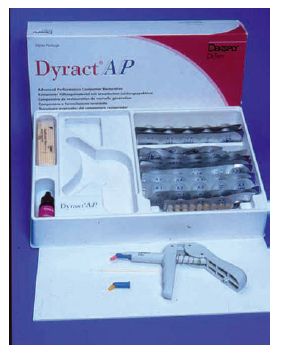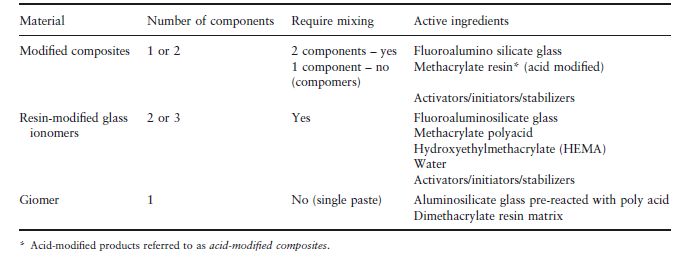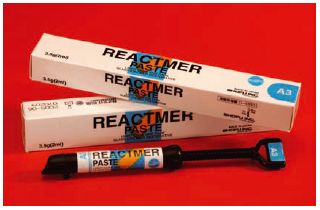Chapter 25
Resin-modified Glass lonomers and Related Materials
25.1 Introduction
In the previous chapters we have considered two of the most important groups of tooth-coloured restorative materials – the composites and glass ionomers. Both products have advantages and disadvantages which are summarized in Table 25.1. The properties of these materials dictate that no single material from either group is suitable for all applications and that materials selection requires a decision on the part of the dentist which takes account of the limitations of the products. It was recognized that if it were possible to combine the characteristics of the two types of product it may be possible to produce a hybrid material which possesses the most advantageous properties of both materials whilst at the same time overcoming some of the disadvantages. Early attempts at producing hybrid products involved blending together components of commercially available glass ionomer and composite materials to produce a material which, though not viable as a clinically usable product, demonstrated the possibility of combining two apparently dissimilar materials. Further research and development has led to a large new family of materials which are diverse in nature but which have a composition which lies somewhere on the continuum between resin–matrix type composites and acid–base reaction type cements. At the one extreme of the continuum they can be viewed as composite materials in which a modified resin and a reactive glass have been used. At the other extreme they can be viewed as acid–base cement matrix products with added resin.
Fig. 25.1 gives some indication of the materials which lie on the continuum. The figure indicates very approximately the nature of the materials in terms of the relative contribution of cement or resin matrix from which it is possible to develop a profile of expected properties.
25.2 Composition and classification
There has been considerable controversy over the terminology used to describe materials which fall into the categories lying between composites and glass ionomers. An ISO Standard (ISO 9917–2) for light-activated water-based cements describes the products as water-based and setting by multiple reactions which include an acid-base reaction and polymerisation. An attempt has been made to further sub-divide products in these categories into modified composites and resin-modified glass ionomers (Table 25.2).
Variations on these materials occasionally produce other new categories, one example being the ‘giomers’. However, these new categories often turn out to be very similar to one of the existing groups. The giomers, for example are very similar to the modified composites or compomers.
Modified composites. Some products are essentially resin–matrix composites in which the usual insert filler has been replaced by an ion-leachable aluminosilicate glass in order to encourage fluoride release. No acid–base reaction takes place during the setting of these materials. Setting is through free radical polymerisation of methacrylate groups (often light-activated). In some materials the resin, in addition to the normal dimethacrylate components, also contains acidic (normally alkenoic) groups in order to generate the possibility of an acid–base reaction with the glass component. These products are often referred to as acid-modified composites. The term compomer has also been used to describe these products. The primary setting reaction is still through polymerisation of methacrylate groups in the resin component. The acid part of the modified resin is unable to enter into an acid–base reaction with the glass due to the absence of water from any of the material components. Indeed, the most widely used materials from this category are supplied premixed in small single dose syringes (Fig. 25.2). Since the modified resin and glass are pre-mixed and stored in the syringe before use, the exclusion of water is essential in order to prevent premature setting. This is normally achieved by packaging each small syringe in a waterproof foil container. Following setting through polymerisation it is thought that some acid–base reaction can occur as the resin takes up water and the acid groups become ionized. This process may enable the surface of the glass particles to react in order to liberate fluoride.
Table 25.1 Summary of the advantages and disadvantages of composites and glass ionomers.
| Material | Advantages | Disadvantages |
| Composite | Strong | No inherent adhesion |
| Tough | Shrinkage | |
| Insoluble | No fluoride release | |
| Radiopaque | ||
| Quick setting | ||
| Glass ionomer | Inherent adhesion | Brittle |
| Little shrinkage | Soluble | |
| Fluoride release | Not radiopaque | |
| Biocompatible | Wear | |
| Water sensitive | ||
| Slow setting |
Fig. 25.1 An illustration of how materials may have a matrix composition which comprises a blend or mixture of resin and salt components lying between the extremes of a dental composite having a purely resin matrix and a conventional GIC having a salt matrix.

Fig. 25.2 An illustration of an acid modified composite material, often referred to as compomers, supplied in single dose syringes called compules. The material can be injected from the compule directly into the cavity using the device shown in the picture. Setting of the material is then activated by light.

Table 25.2 Summary of the nature of the available materials.

Giomers. These products are similar to the acid-modified composites except that the acid-base reaction is completed before blending the filler with resin. The aluminosilicate glass is reacted with polyacid in order to form a pre-reacted glass-polyalkenoate complex. Two distinct products are produced. The first, known as surface reaction type, involves breakdown of only the surface layers of the glass particles. The second, known as full reaction type (Fig. 25.3), involves almost complete breakdown of the original glass particles. Following this initial reaction, the product is ground and blended with a dimethacrylate resin to form a composite structure. A notable feature of the full reaction type materials is the fact that some hydroxyethylmethacrylate is required in order to enable mixing of the hydrophobic resin with the fully reacted glass. The principle of the formulation and manufacturing process is that fluoride is released from the glass particles during the acid-base reaction and when the glass-polyalkenoate complex is blended with resin the fluoride becomes available for release. In the surface reaction products only the surfaces of the glass particles are consumed and for these products the mechanical reinforcing effect of the filler particles is given priority over fluoride release. For the full reaction products fluoride release is prioritized at the expense of mechanical properties.
Both the full reaction and surface reaction type products are provided to the dentist as single paste materials which set through light-activated free radical addition polymerisation of methacrylate groups in the usual way (see Sections 12.2 and 22.4).
Resin-modified glass ionomers. These products are considered by some authorities to be more truly based on a hybrid of the two parent groups of materials. In their simplest form they consist of a powder and liquid which require mixing prior to activation of polymerisation (often by light activation). The most convenient of the restorative type resin-modified glass ionomers are provided in an encapsulated form in which the powder/ liquid ratio is determined by the manufacturer and the mixing is carried out mechanically in only a few seconds (Fig. 25.4). The powder consists primarily of an ion-leachable glass whilst the liquid contains four main ingredients:
Fig. 25.3 An illustration of a giomer material supplied as a light activated paste in a syringe. This material contains filler particles consisting of a pre-reacted glass ionomer blended into a paste with resin.

Stay updated, free dental videos. Join our Telegram channel

VIDEdental - Online dental courses


